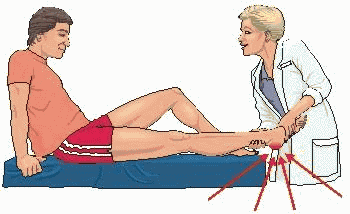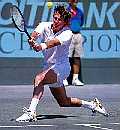<% ns_puts [mkm_getnavbar] %>
Heel Pain
by Dr. Simon Small
Whether
you've been playing tennis for 4, 24 or 40 years, you may at some
point experience heel pain. This article is the first in a series that I
hope will be helpful to athletes who want to better understand what
problems they may experience in their feet, which ultimately affect how
they feel both on and off the court. By taking a few moments now to
understand the origin of your discomfort, you may prevent it from
reoccurring. Don't despair-your game is only temporarily kaput!
Heel
pain is uncomfortable and annoying because it interrupts your ability to
play, but the good news is it is treatable without surgery. It is an
overuse injury, like a muscle strain, ligament tear or ankle sprain. It
starts suddenly and you have to deal with it, because the sharp, burning
pain rarely goes away on its own. Since your foot has been compensating,
each time your heel touches the ground it uses muscles that should be at
rest, not stretched.
|
There
are several reasons why heel pain occurs. If you suddenly become active
after a prolonged period of time, or if you haven't sufficiently trained
for a rigorous workout, you may feel pain immediately. Heel pain also
stems from a mal-alignment of the foot that causes increased stress in the
heel area during walking or activity. This underlying structural
abnormality won't allow your foot to absorb shock normally. An example of
this is flat feet, meaning you have a flattened arch that causes an
increased stretch of the plantar fascia ligament. Heel pain can also
result from other conditions such as gout, arthritis, psoriasis, collagen
disorders, nerve injuries and tumors.
Don't Delay
Treatment
It's
difficult to get rid of heel pain without professional care. If you wait
weeks or even months before seeing a podiatrist, the soft tissue of the
heel can become inflamed leading to stress on the heel bone itself. If
your foot has a structural abnormality, your podiatrist might recommend
physical therapy, cortisone injections, or a pad or orthotic (custom
designed foot support placed in the shoe to add balance, support, and bio-mechanical control to the foot) in
your shoe. Your doctor might prescribe oral non-steroidal
anti-inflammatory medications and tell you to ice down and take some time
off from training. When you resume, at first you'll train less
aggressively and incorporate stretching of about 30-45 seconds in
duration. Then on the court you will slowly increase the amount of time
you play to enable your muscles to feel as comfortable as possible.
shoe to add balance, support, and bio-mechanical control to the foot) in
your shoe. Your doctor might prescribe oral non-steroidal
anti-inflammatory medications and tell you to ice down and take some time
off from training. When you resume, at first you'll train less
aggressively and incorporate stretching of about 30-45 seconds in
duration. Then on the court you will slowly increase the amount of time
you play to enable your muscles to feel as comfortable as possible.
After Your
Workout
The basic regimen to follow is one you've heard over and over - rest, ice, compression, elevation (RICE) and then more ice. After play, as soon as possible, use ice cubes on your feet to vigorously massage the area for three-five minutes. For a chronic problem, warm water soaks are more effective in the morning. Before play, make sure to wear thick-soled shoes at all times to cushion the heel area during activity. Above all, avoid vigorous activity until your doctor or trainer says you're healing (no pun intended), because a workout places far more pressure on the foot.
|
A Support Could
Help
Depending on
your level of play, you may need a subtle balance enhancement for your
shoe. A "full contact support" is a combination foot liner and
arch support. It cushions the ball of the foot and enables the heel to
meet the floor at a position that does not stress the heel. The support
creates a better neutral position of the foot to leg relationship so the
heel won't drop, which is what causes strain by stretching the muscles in
the back and bottom of the foot. A full contact support also keeps the
heel from moving side to side.
Time needed for
recovery varies, depending upon how well you follow your podiatrist's
guidelines and how diligently you do the exercises mentioned later in this
article. Surgery is rarely done because the full contact support or
orthotics can often correct the problem. Surgery is usually a last resort
for those whose symptoms have existed for quite some time. Your specialist
may also temporarily tape or strap your foot in position while your
orthotics are being made.
As an athlete,
if you are unable to straighten or bend your knee, the contact point
becomes greater on your forefoot. The overuse occurs when the muscle has
to stretch. Gravity tries to bring the heel to the ground but your muscles
try to resist the stretch. Yet gravity will win out causing the heel pain
trauma, that can't be undone quickly.
The following
exercises done several times weekly, will help minimize overuse injuries
to the feet:
-
Stretch the ligaments in your ankles by doing "figure eights"
-
Extend your left foot in front of your right one: stretch the Achilles tendon of the rear leg by bending the front leg with hands on knee. Force your weight back toward the ground through the back heel.
-
Face a flight of stairs, placing both forefeet parallel to the front edge of the same step. Without bouncing, relax and allow gravity to pull your heels downward for about 20 seconds.
-
Face a wall with both heels on the ground; place your hands on the wall at shoulder height and width apart; extend your chest, back and waist straight so that they and your nose touch the wall. Keep your heels on the ground and your body straight, except for bending at the ankle joint.
Whether you're nine or 90, a social player or a competitor, you can take steps toward avoiding heel pain. Treat your feet well, stay flexible, and enjoy your game.
 As a Diplomat of the American Board of Podiatric Surgery, a Fellow of
the American College of Foot Surgeons and the American Academy of
Podiatric Sports Medicine, Dr. Small brings the expertise of twenty years
of experience in this field. Dr. Small serves as a consultant to the
football, baseball, tennis, and basketball officials, as well as the
Sports Medicine Department of Villanova. His patients include many
professional athletes.
As a Diplomat of the American Board of Podiatric Surgery, a Fellow of
the American College of Foot Surgeons and the American Academy of
Podiatric Sports Medicine, Dr. Small brings the expertise of twenty years
of experience in this field. Dr. Small serves as a consultant to the
football, baseball, tennis, and basketball officials, as well as the
Sports Medicine Department of Villanova. His patients include many
professional athletes.
As a member of the Medical Advisory Committee of the United States Squash Racquet Association and Director of Education for Pro Support Systems, he has traveled all over the country and Europe giving lectures at various facilities, screening and evaluating athletes for lower extremity preventive sport injuries at different squash and tennis tournaments, including the U.S. Open, Copperbowl Junior Tennis Tournament, The Easter Bowl Tennis Tournament and in Europe, at the French Open and Wimbledon.
For more information on Dr. Small, Pro Support Systems and/or orthotics, click on ProSupportSystems.com.
Last Updated 9/1/98. To contact us, please email to: webmaster@tennisone.com
TennisONE is a registered trademark of TennisONE and SportsWeb ONE; Copyright 1995. All rights reserved.

 Heal
pain can be caused by sudden rigorous or prolonged activity without
sufficient training.
Heal
pain can be caused by sudden rigorous or prolonged activity without
sufficient training.  Full
contact supports can cushion the ball of the foot and enable
the foot to meet the floor at a position that does not stress the
heel.
Full
contact supports can cushion the ball of the foot and enable
the foot to meet the floor at a position that does not stress the
heel.